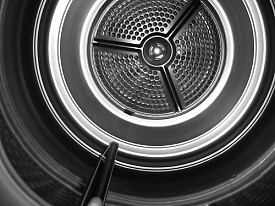Is Your Dryer Running Efficiently?
 As a renter, I don't necessarily get a lot of control over my appliances. And recently the dryer has started acting up, taking longer and longer and longer to dry a load of laundry. I know it's eating up a ton of energy, because my electrical bill has skyrocketed, and I know that's bad for the environment, something I don't want for my otherwise green laundry room. While I have a call out to the landlord to come take a look, it's worth discussing how to troubleshoot a fractious dryer...and how to know when it's time to throw in the towel and buy a new one.
As a renter, I don't necessarily get a lot of control over my appliances. And recently the dryer has started acting up, taking longer and longer and longer to dry a load of laundry. I know it's eating up a ton of energy, because my electrical bill has skyrocketed, and I know that's bad for the environment, something I don't want for my otherwise green laundry room. While I have a call out to the landlord to come take a look, it's worth discussing how to troubleshoot a fractious dryer...and how to know when it's time to throw in the towel and buy a new one.
Lint Trap
If your dryer is taking forever or doesn't seem to heat at all, your first stop should be the lint trap. It seems obvious, I know, but a surprisingly large number of people don't check and empty their lint traps on a regular basis. It's a good idea to clean it before or after every load. In addition to helping your dryer run more efficiently, this also reduces the risk of fire! (P.S. You can compost that lint, by the way.)
Valve or Vent
For gas dryers, a common cause of low heat is a supply valve that's not fully open. Electric dryers won't work if one of their breakers has tripped (if you still have fuses, a blown fuse can be the cause too...and you might want to think about upgrading your electrical panel). Another common cause is a blocked dryer vent, which fools the dryer into thinking it's too hot. Check the hose or pipe connected to the vent, because if it's blocked or kinked, it will block the flow of air.
Laundry Room Temp
Is the dryer in a cold room? You might have the heat down in the laundry room for efficiency, but if it's too cold, your dryer will struggle to heat. Keep the heat at a minimum of 45 degrees for best results, and make sure your dryer has plenty of air circulation around it to allow all the vents to operate freely. If your home heating isn't consistent, talk to a Chicago HVAC technician about inspecting the heating system and running a routine maintenance check.
Heating Components
The heating element or gas valve solenoid could be the culprit as well. These components of the dryer help it heat up, and if they're not working, it's not going to work either! Use a continuity tester to check the heating element in an electric dryer, and replace it if it's broken. To check the solenoid, watch the igniter: if it fails to ignite the gas coils, they need to be replaced.
Blower Wheel
It's possible your blower wheel might be broken, too. Take the vent on the back of the dryer off and have a look at the airflow. If it's low or nonexistent, it's time to check the blower wheel, and possibly to replace it. Here's a handy video guide on how to do it!
Moisture Sensor and Thermistor
Components like the moisture sensor and thermistor, designed to automatically detect moisture levels and adjust the dry cycle, can also fail. If your basic troubleshooting hasn't identified an obvious mechanical problem, it's time to start taking a look at these parts to see if they need to be replaced.
Overloading
You may also be overloading your machine: try smaller dry loads to see if this makes a difference.
Repair or Replace?
The decision to replace a dryer can depend on a number of factors. If your dryer repair will cost a lot and the machine is aging, replacing it might be worthwhile, because you can get a more efficient model. On the other hand, repair is generally better than replacement when possible because it's more environmentally friendly to keep what you have than to buy something new. Weigh the costs of replacement carefully. And take advantage of review services like Consumer Reports to get the skinny on available models so you'll make the best choice.
If you do decide to replace your dryer, have a qualified gas plumber or electrician do the work.
Katie Marks writes for Networx.com.
Updated September 2, 2018.
Looking for a Pro? Call us (866) 441-6648

Electrical Average Costs
Electricians Experiences

Electrical Upgrade Including New Breakers And Replacement Wiring

Whole House Fan Installation Saves Me Money On Electricity



